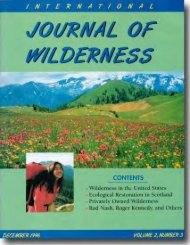Download full PDF - International Journal of Wilderness
Download full PDF - International Journal of Wilderness
Download full PDF - International Journal of Wilderness
You also want an ePaper? Increase the reach of your titles
YUMPU automatically turns print PDFs into web optimized ePapers that Google loves.
The following response rates were<br />
obtained: 66% (n = 361) for the Cohutta,<br />
68% (n = 343) for the Comanche Peak,<br />
and 68% (n = 232) for the Okeefenokee.<br />
However, since the Okeefenokee sample<br />
was composed entirely <strong>of</strong> overnight users,<br />
and in order to reduce variation<br />
across users <strong>of</strong> the different areas, dayhikers<br />
were excluded from the analysis.<br />
This resulted in the following sample<br />
sizes: Cohutta (n = 192), Comanche Peak<br />
(n = 91), and Okeefenokee (n = 232).<br />
Measurement <strong>of</strong> Variables<br />
Visitor concern for conditions was measured<br />
by asking respondents to rate how<br />
concerned they were generally with<br />
physical setting conditions in wilderness<br />
on a six-point polar scale from “unconcerned”<br />
to “extremely concerned.” A total<br />
<strong>of</strong> 33 condition items representing<br />
social (8 items), physical (14 items), and<br />
managerial (11 items) domains were used<br />
(see Table 1). Perceptions <strong>of</strong> setting conditions<br />
were assessed by asking visitors<br />
to indicate how they found the same 33<br />
conditions to exist at the particular wilderness<br />
area they visited (see Table 2).<br />
Items were rated on a 6-point polar scale<br />
from “very poor” to “excellent.” Differences<br />
among the three wilderness areas<br />
were made using the AN OVA procedure<br />
in SPSS/PC+Version 2.1 (Norusis 1991).<br />
Concern for<br />
<strong>Wilderness</strong> Conditions<br />
The results will be presented and discussed<br />
in terms <strong>of</strong> rankings <strong>of</strong> items and<br />
mean values <strong>of</strong> items. Rankings represent<br />
relative values while means indicate absolute<br />
levels <strong>of</strong> concern and perceptions.<br />
Table 1 shows that rankings <strong>of</strong> concern<br />
for wilderness conditions were generally<br />
similar across the three areas. Consistent<br />
with findings <strong>of</strong> Roggenbuck and others<br />
(1993), litter (along the trail and in campsites),<br />
vegetation/tree damage, and noise<br />
were among the top five concerns <strong>of</strong> all<br />
three user groups. Management activities<br />
(amount <strong>of</strong> ranger contact, number <strong>of</strong><br />
rangers seen, number <strong>of</strong> signs and trail<br />
markers) were among the conditions <strong>of</strong><br />
least concern for users <strong>of</strong> all three areas.<br />
There were, however, some exceptions to<br />
the similarity in rankings: two social issues<br />
(“amount <strong>of</strong> noise heard from out-<br />
side the wilderness” and “number <strong>of</strong><br />
groups that pass within sight <strong>of</strong> the<br />
camp”) ranked a much lower level <strong>of</strong> concern<br />
with eastern visitors who, on the<br />
other hand, ranked “the amount <strong>of</strong> mature<br />
forest” a much higher level <strong>of</strong> concern<br />
than did visitors to Comanche Peak.<br />
Looking at absolute rather than relative<br />
differences among concern levels,<br />
significant differences in mean concern<br />
scores occurred for 23 <strong>of</strong> the 33 items.<br />
This suggests that visitors to the three<br />
areas differed in the amount <strong>of</strong> concern<br />
they held for conditions in wilderness<br />
generally Overall, Okeefenokee visitors<br />
indicated the highest concern while<br />
Comanche users expressed the lowest<br />
concern. For example, Comanche Peak<br />
visitors were significantly less concerned<br />
than Okeefenokee visitors on 78% (18)<br />
<strong>of</strong> the significant difference items and less<br />
concerned than Cohutta visitors on 48%<br />
(11) <strong>of</strong> these items. Cohutta visitors fell<br />
in the middle, being less concerned with<br />
THE INTERNATIONAL JOURNAL OF WILDERNESS Volume 3, Number 4 31










